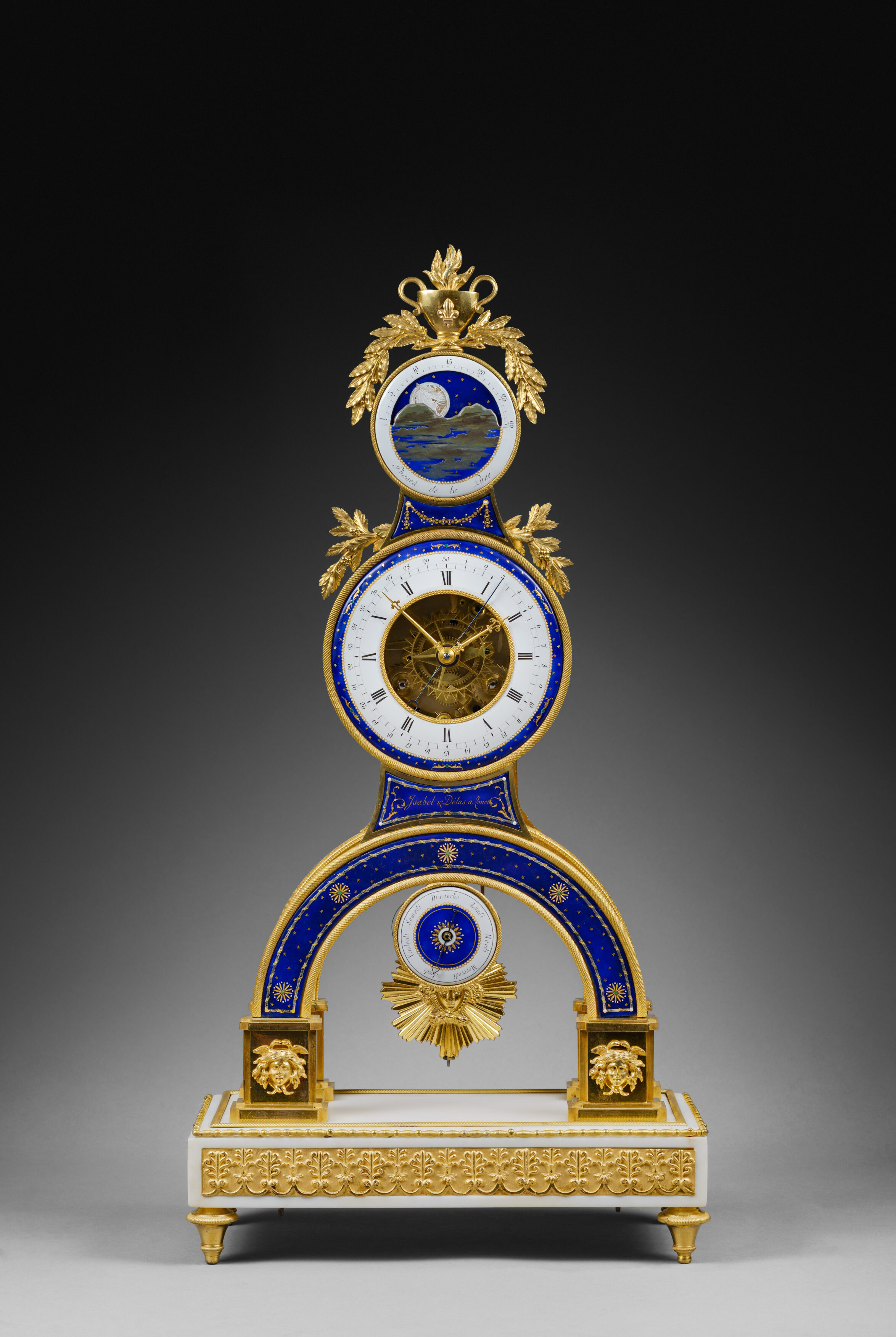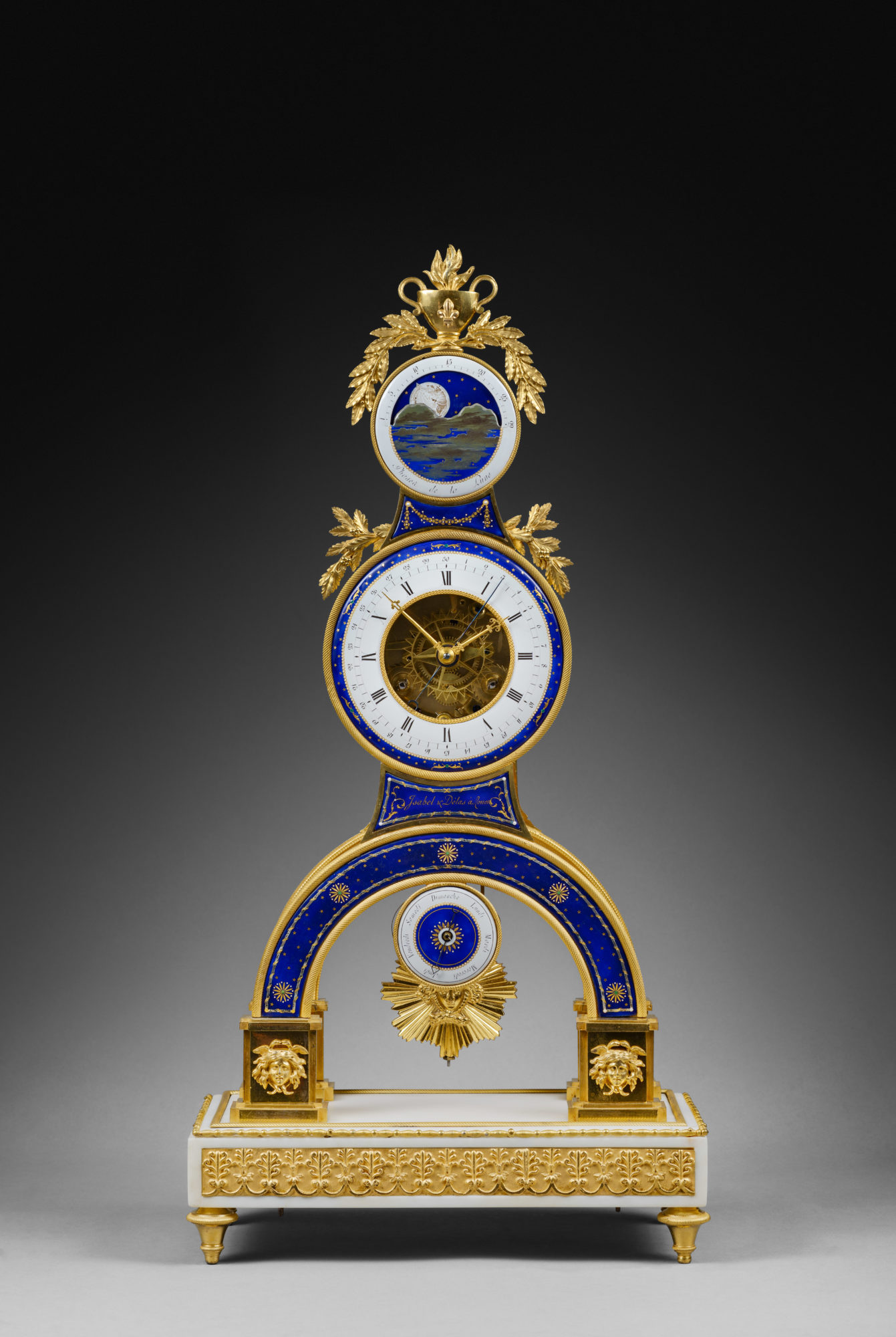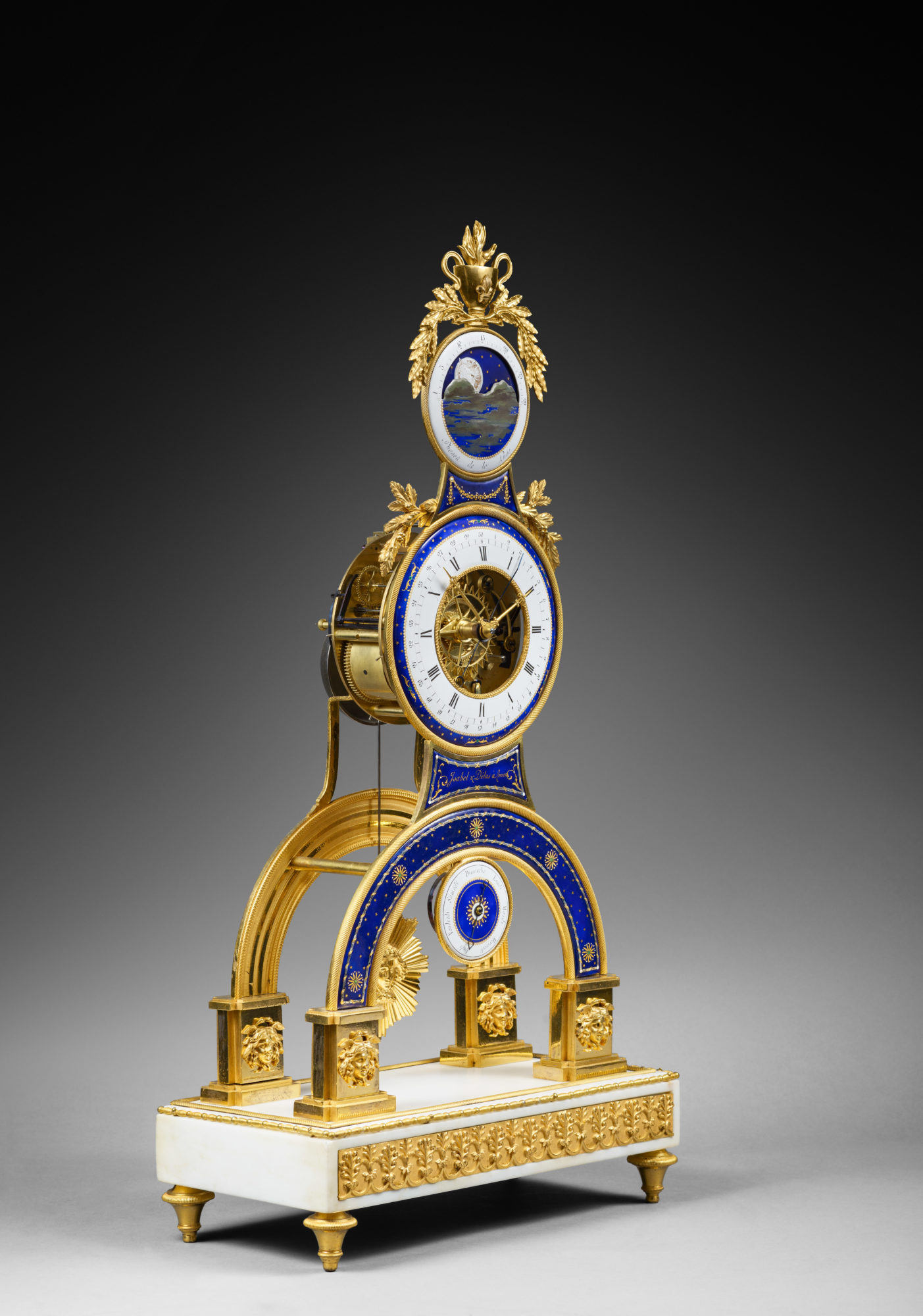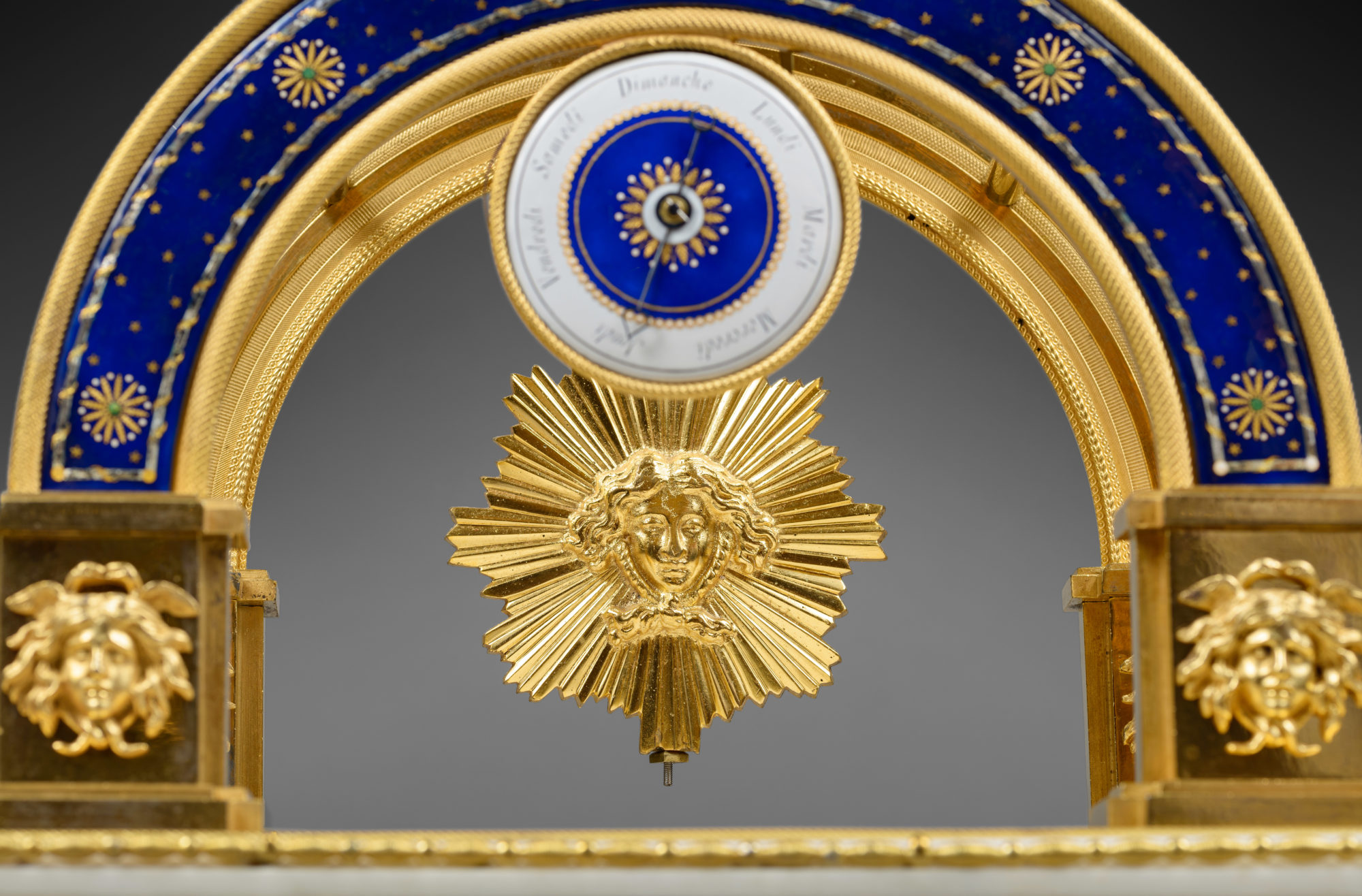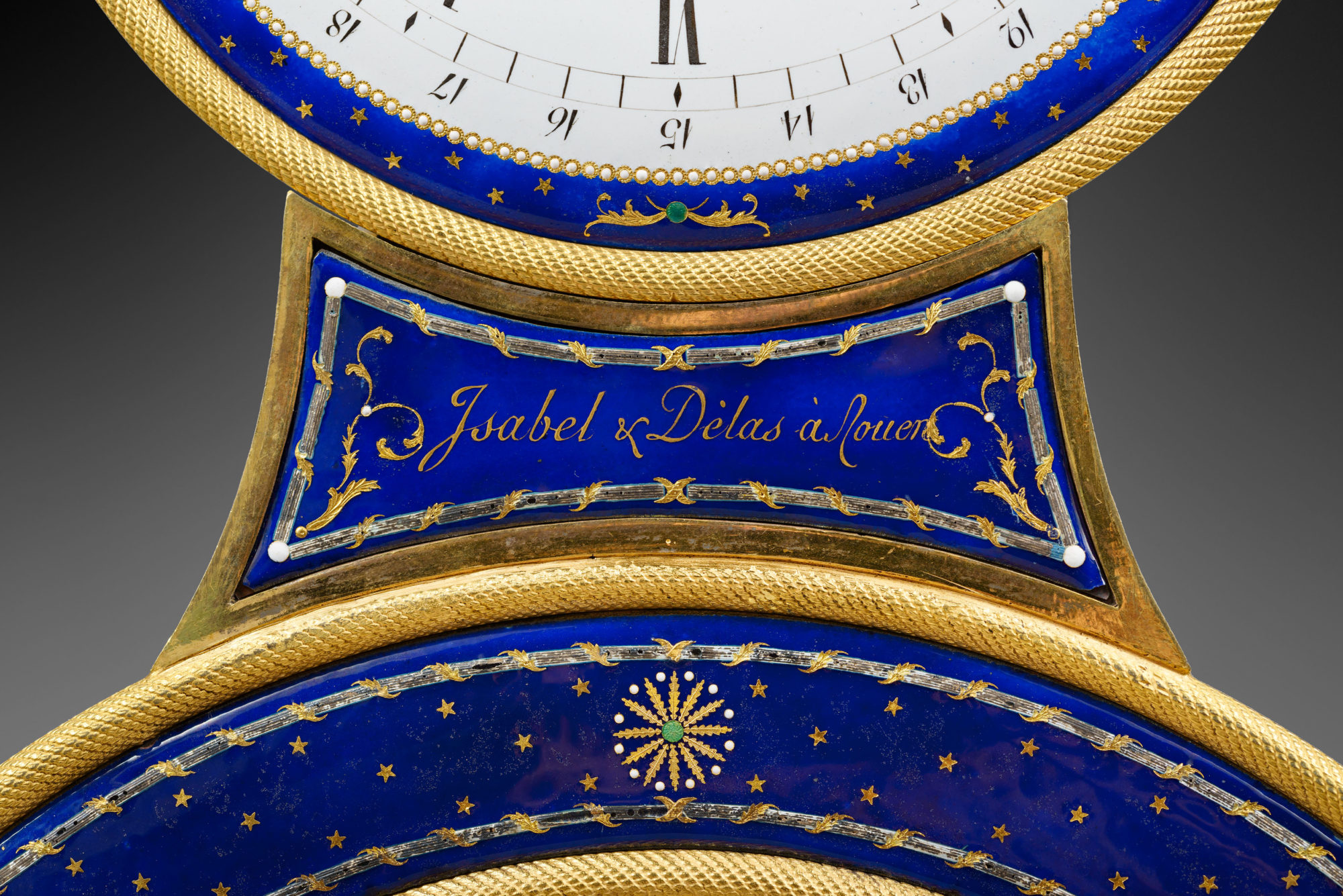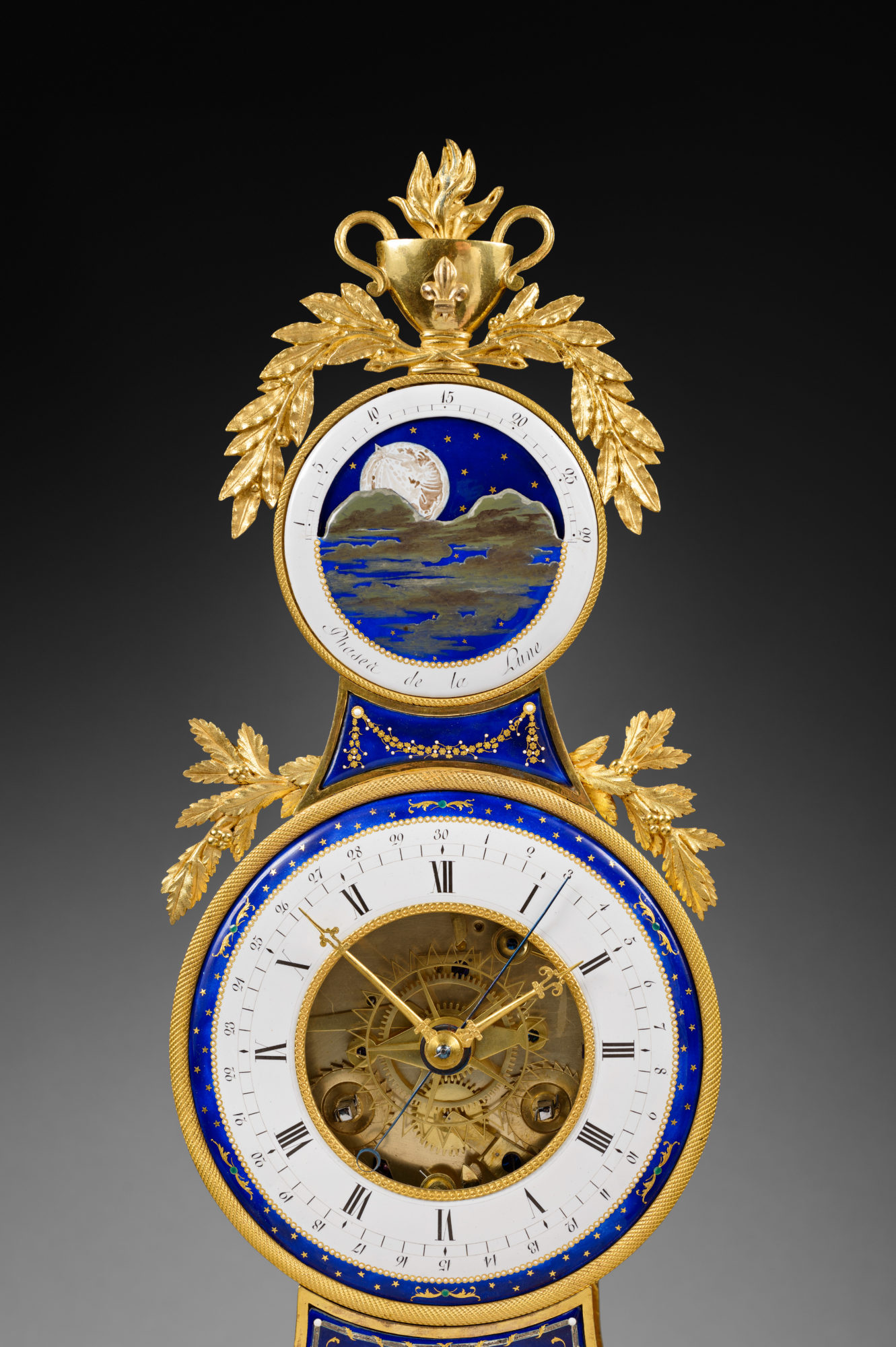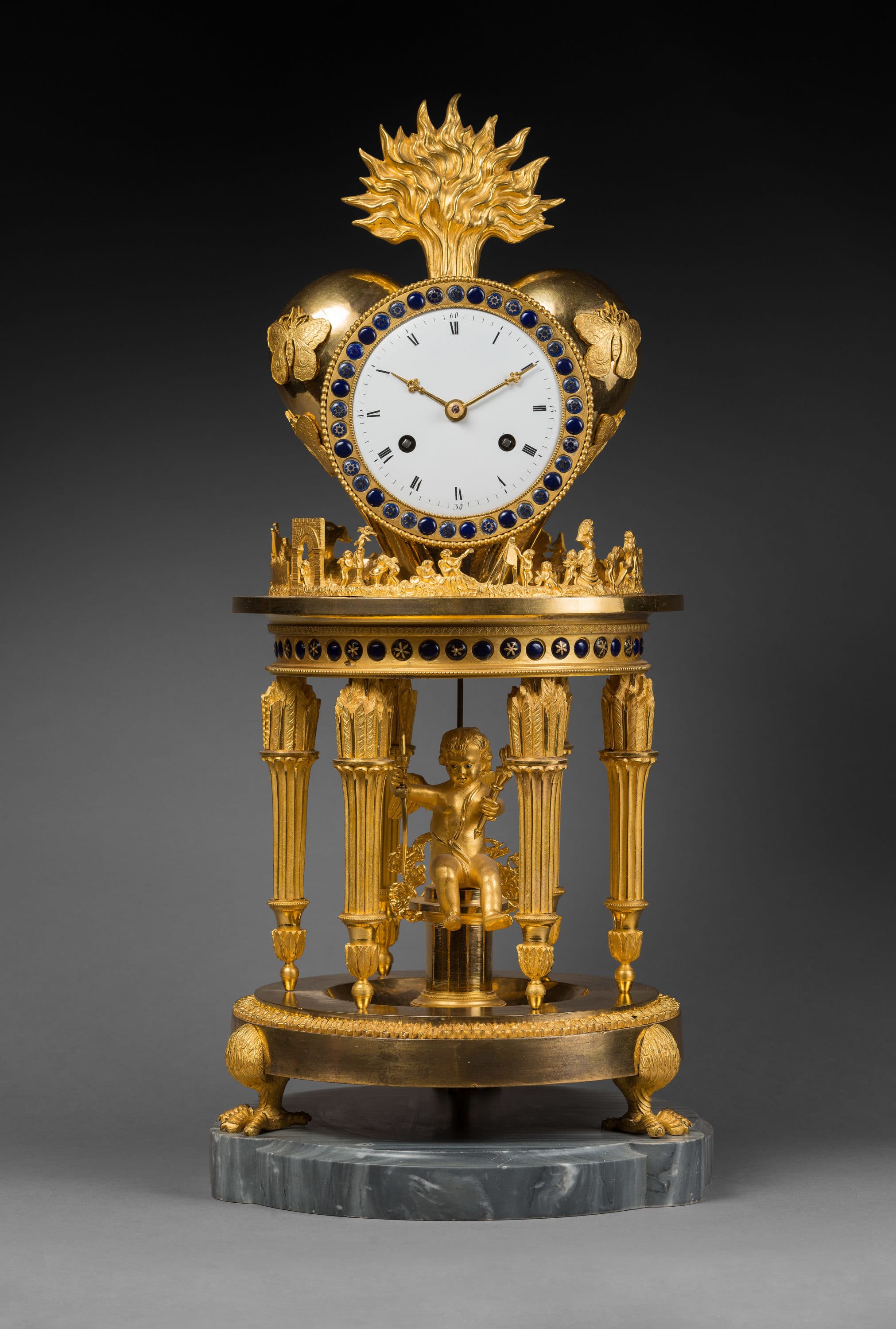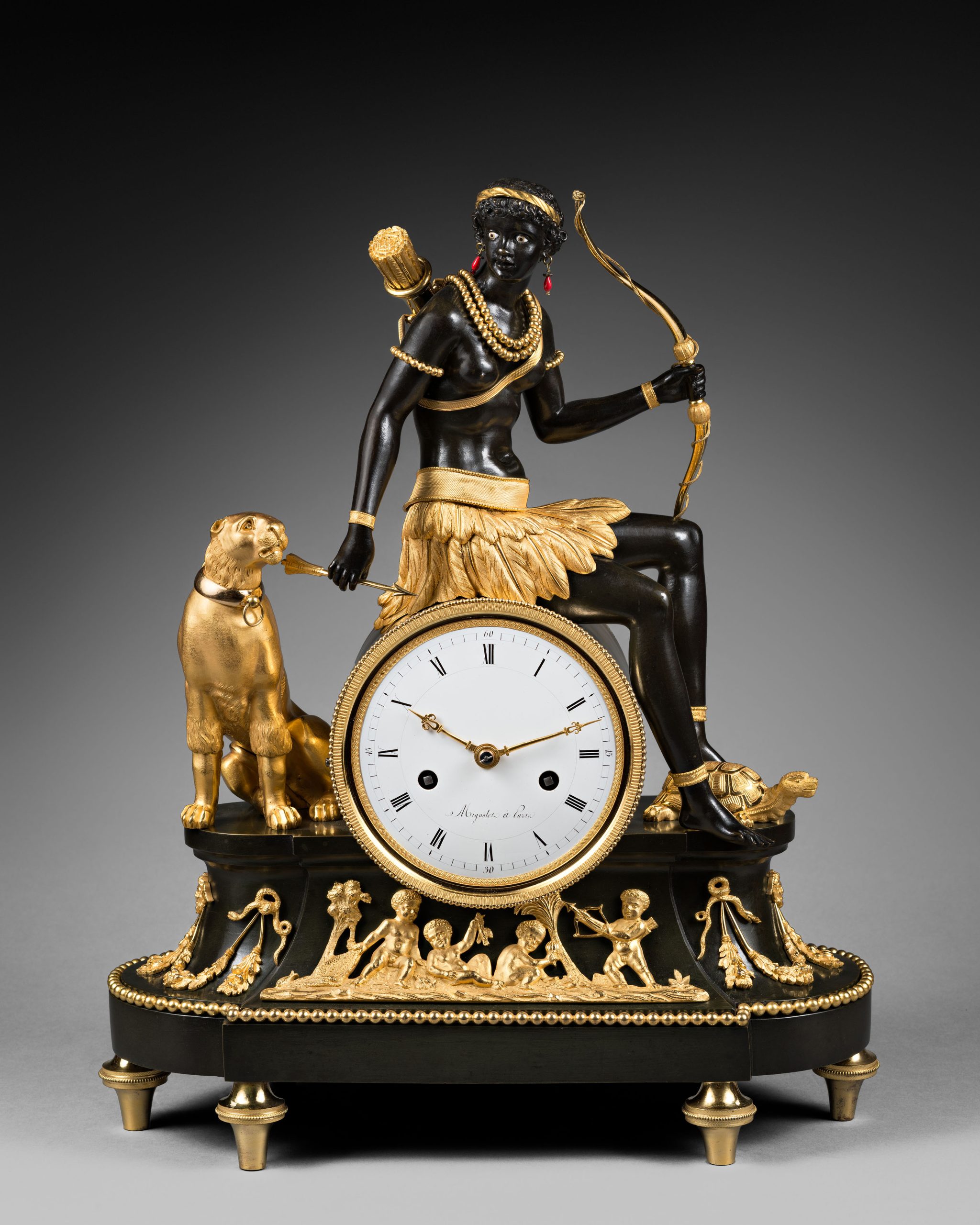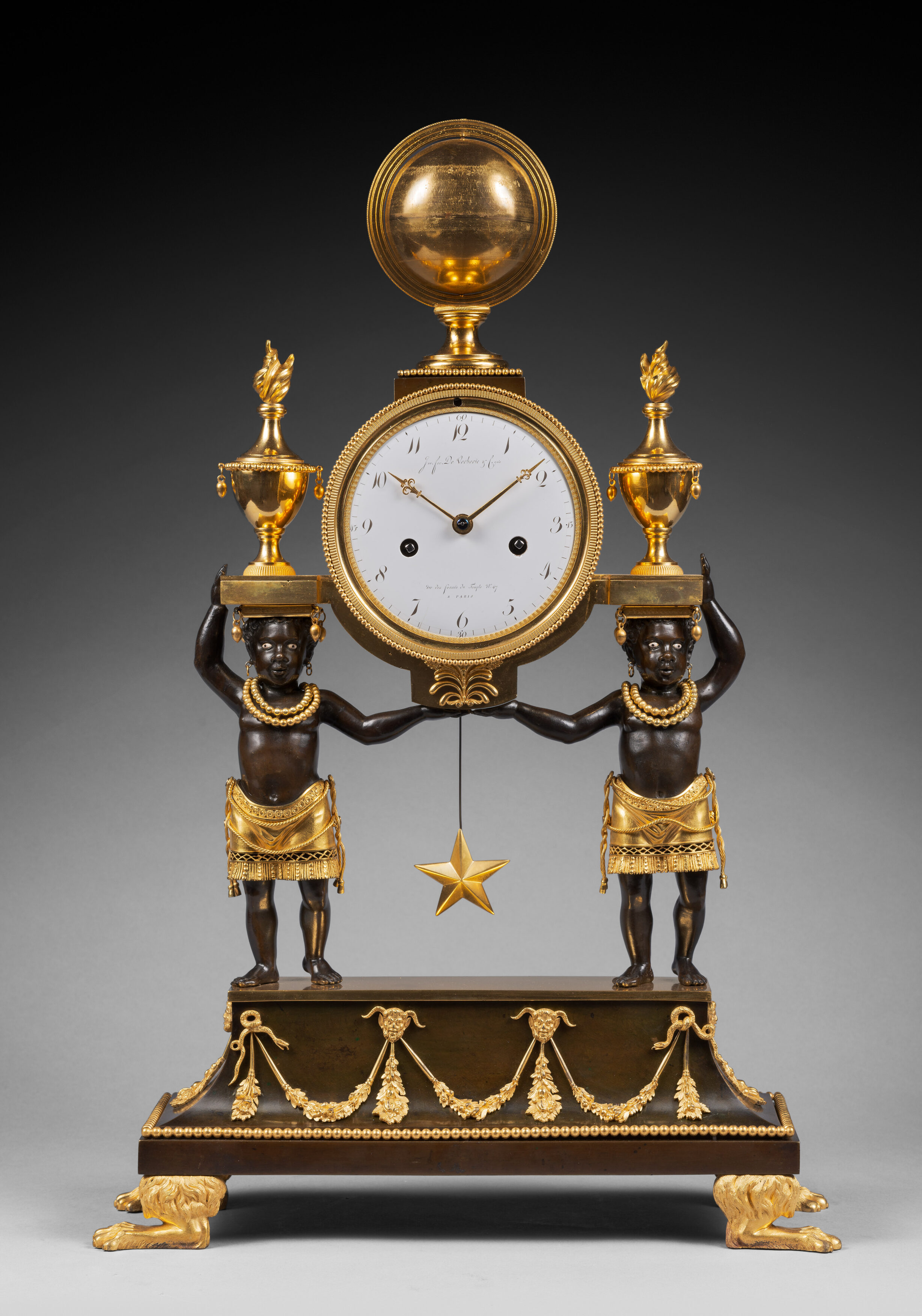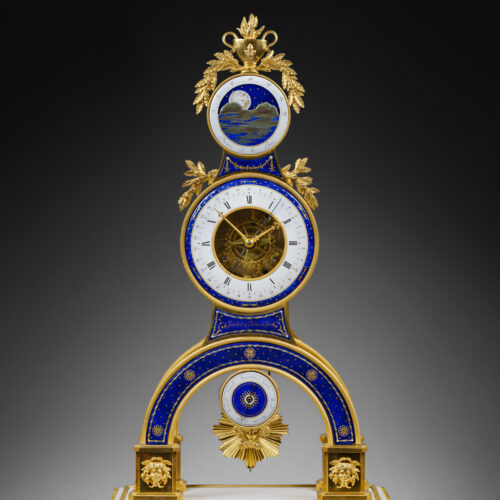Rare Enamel, Gilt Bronze and White Carrara Marble Skeleton Clock
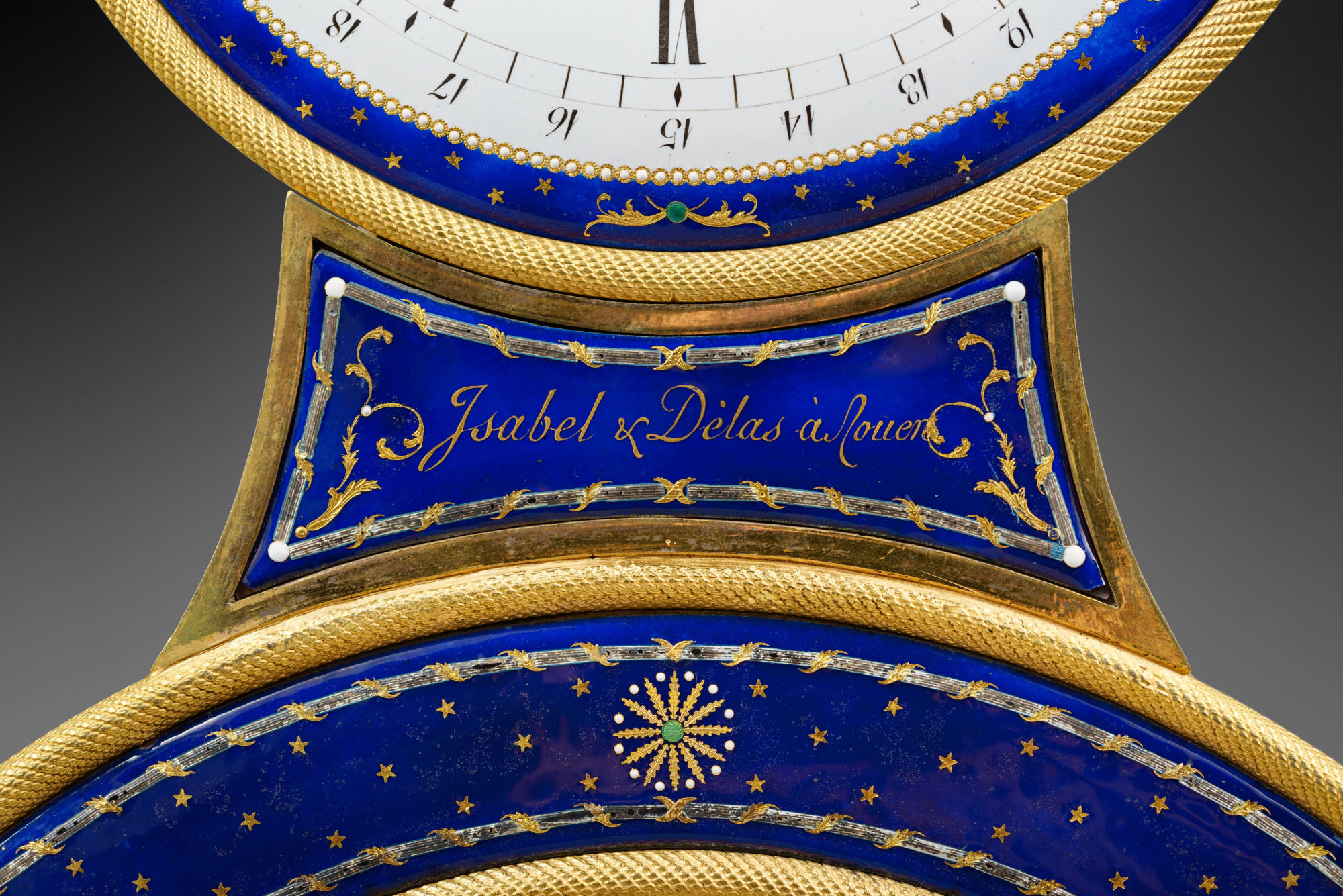
« Isabel & Délas à Rouen »
The Enamels Attributed to Joseph Coteau
France, Directory period, circa 1795
The main enamel ring dial, with a star-strewn blue enameled border, reveals a portion of the movement’s finely cut gears. It indicates the Roman numeral hours and the Arabic numeral minute graduations and revolutionary date, graduated from 1 to 30, by means of three hands, two made of pierced gilt bronze and the third of blued steel. A second white enamel dial, with a central blue enameled disc is set under the main dial; it indicates the days of the week, by means of a blued steel hand. A third dial, surmounting the other two, indicates the age and phases of the moon on two enamel discs. The two-barrel eight-day going movement, with outer count wheel and knife-edge suspension, strikes the hours and half hours on a bell. The pendulum is in the form of a magnificent Apollo mask with radiating sunrays.
The three dials are set within a framework adorned with blue enamel decorated with gold and silver motifs, including rosettes centered by green cabochons. A shaped cartouche bears the signature “Isabel & Délas à Rouen”. The clock is elaborately adorned with finely chased gilt bronze mounts and is surmounted by a flaming urn with handles that is adorned with an applied fleur de lys. The framework is decorated with knurled molding, seeded laurel branches, and two ribbon-tied olive branches. It rests on two arches that are set on square columns, whose capitals and bases have cutout corners, and are decorated with masks of Mercury. The clock rests on a quadrangular white marble base that is adorned with a beaded frieze and whose façade has a reserve with a frieze of alternating palmettes and stylized stems. The clock is raised upon four knurled and gadrooned toupie feet.
Discover our entire collection of antique skeleton clocks for sale online or at the gallery.
La Pendulerie is the specialist in fine and rare antique clocks, based in Paris.
Skeleton clocks first appeared during the last decade of the 18th century. This type of clock features a simple uncluttered design, with a main annular dial that reveals the beauty of the movement and its gear trains, and the complexity of the mechanisms. These were made by the finest clockmakers in Europe, most of whom worked in Paris. The new esthetic style grew partially out of clock lovers’ admiration for the extraordinary technical progress made during the 18th century, as well as from an increasing lack of interest in allegorical clocks depicting Greek and Roman mythological figures. The present clock, made within this context, features an elegant and luxurious design that typifies the best of the French decorative arts during the final decade of the 18th century.
Among the small number of similar clocks known, one example with four dials is in the Royal Spanish Collections (see J. Ramon Colon de Carvajal, Catalogo de Relojes del Patrimonio nacional, Madrid, 1987, p. 95, catalogue n° 78). A second clock, with enamels by Joseph Coteau, is in the Musée François Duesberg in Mons (illustrated in Musée François Duesberg, Arts décoratifs 1775-1825, Brussels, 2004, p.103). A third clock, on display in the Musée Carnavalet in Paris, is illustrated in the exhibition catalogue La Révolution dans la mesure du Temps, Calendrier républicain heure décimale 1793-1805, Musée international d’Horlogerie, La Chaux-de-Fonds, 1989, p. 95. A fourth example, signed “Folin l’aîné à Paris”, is in the Getty Museum in Malibu (illustrated in G. Wilson and C. Hess, Summary Catalogue of European Decorative Arts in the J. Paul Getty Museum, Los Angeles, 2001, p. 74, fig. 145). One further similar clock, whose dial is signed “Laguesse à Liège” and whose enamels by Joseph Coteau are dated 1796, is on display in the Pavlovsk Palace in Saint Petersburg (see E. Ducamp, Pavlovsk, Les Collections, 1993, p. 186, pl. 17).
This signature probably refers to the partnership between Monsieur Isabel, a clockmaker who was active in Rouen during the late 18th century – who may be the same M. Isabelle who in 1802 exhibited a system for compensating for the effect of temperature variations on the rate of clocks – and of Jacques Délas, a clockmaker born in Rouen in 1752, whose marriage took place in that city forty years later (see Tardy, Dictionnaire des horlogers français, Paris, 1971, pp. 170 and 318).
Joseph Coteau (1740 - 1801)
The most renowned enameller of his time, he worked with most of the best contemporary Parisian clockmakers. He was born in Geneva, where he was named master painter-enameler of the Académie de Saint Luc in 1766. Several years later he settled in Paris, and from 1772 to the end of his life, he was recorded in the rue Poupée. Coteau is known for a technique of relief enamel painting, which he perfected along with Parpette and which was used for certain Sèvres porcelain pieces, as well as for the dials of very fine clocks. Among the pieces that feature this distinctive décor are a covered bowl and tray in the Sèvres Musée national de la Céramique (Inv. SCC2011-4-2); a pair of “cannelés à guirlandes” vases in the Louvre Museum in Paris (see the exhibition catalogue Un défi au goût, 50 ans de création à la manufacture royale de Sèvres (1740-1793), Musée du Louvre, Paris, 1997, p. 108, catalogue n° 61); and a ewer and the “Comtesse du Nord” tray and bowl in the Pavlovsk Palace in Saint Petersburg (see M. Brunet and T. Préaud, Sèvres, Des origines à nos jours, Office du Livre, Fribourg, 1978, p. 207, fig. 250). A blue Sèvres porcelain lyre clock by Courieult, whose dial is signed “Coteau” and is dated “1785”, is in the Musée national du château in Versailles; it appears to be identical to the example mentioned in the 1787 inventory of Louis XVI’s apartments in Versailles (see Y. Gay and A. Lemaire, “Les pendules lyre”, in Bulletin de l’Association nationale des collectionneurs et amateurs d’Horlogerie ancienne, autumn 1993, n° 68, p. 32C).
